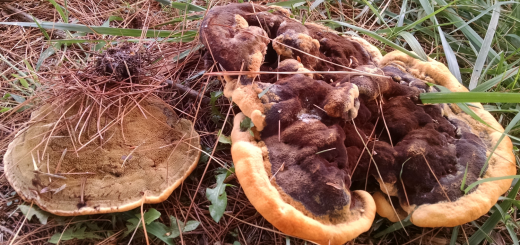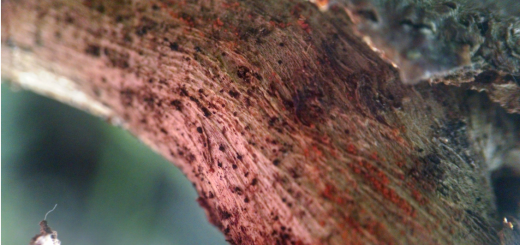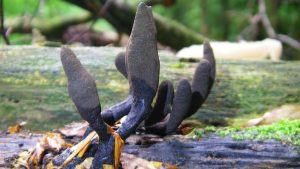#138: Gyromitra esculenta, a False Morel
This is one of the most common false morels. Anyone hunting morels should be familiar with false morels, since they appear at the same time and are potentially deadly. Gyromitra esculenta can be distinguished from other false morels by its brain-like texture, reddish-brown color, and relatively thin stem. Most people just call esculenta a “false morel,” but it has some other common names, including: “Brain Mushroom,” “Beefsteak Morel,” “Lorchel,” and “Turban Fungus” (the last name is used in Europe).
G. esculenta is the mushroom equivalent of brain coral. The most distinctive part of this mushroom is its cap, which is reddish-brown and features brain-like wrinkles. It is also irregularly lobed, but generally not saddle-shaped. Usually, the cap is wider than it is tall, growing between 3-12cm (1-5in) wide and 4-8cm (1.5-3in) tall. The cap is attached to the stipe at multiple points at the top and hangs down over the top part of the stipe. On the stipe side of the cap, which is not exposed to sunlight, extra colors are not produced and the cap is colored like the stipe. G. esculenta is fairly resistant to decay and can be found long after it first fruited. However, its colors darken in age and become nearly black.
The stipe is rather unremarkable. It grows 3-9cm (1-3.5in) tall and 1-3.5cm (0.5-1.5in) thick and is smooth, lightly folded, and colored yellowish or light tan, sometimes with tones of pink or reddish-brown. Although it is normally round or mostly round when sliced, the stipe is often pinched in on both sides to give it a figure eight shape when sliced. Inside the stipe, the flesh is thin, brittle, and often contains numerous chambers.
G. esculenta can be found in Europe as well as North America. The mushroom is widespread and can be found in many habitats, but is more common in northern and mountainous areas. Usually, G. esculenta is found under conifers, with which it may form mycorrhizae. Although listed as a saprobic species, this mushroom may behave like the true morels and live as a saprobe during one stage in its life cycle and as a mycorrhizal partner during another.
False morels can, of course, be confused with true morels. However, true morels are fairly easy to differentiate. When sliced in half, true morels have a single, large, hollow cavity that runs from near the top of the cap to the bottom of the stipe. False morels, on the other hand, are either solid or have numerous, small chambers (that are often filled with cottony material). Additionally, a true morel’s cap is attached to the stipe for at least half of its length while false morels are attached only at the very top of the stipe.
Mushroom hunters who have seen a true morel before are more likely to confuse G. esculenta with another species of false morel. Other false morels have larger folds on their caps (which makes them look less like a brain), have much thicker stipes in proportion to their caps, and most have stems with sharp corners (G. esculenta’s stipe has smooth folds). Some have caps that are saddle-shaped, which is unusual in G. esculenta.
Most authors treat G. esculenta as a poisonous species, despite the fact that it is a desired edible in certain areas (indeed, ‘esculenta’ means ‘edible’). Eaten raw, the mushroom is most certainly poisonous and can be deadly. To make it edible, the mushroom must be parboiled multiple times. Even then, it may still contain enough toxins to make you sick. Toxins can also be inhaled during the parboiling process, causing illness and possibly death. Along with other false morels, G. esculenta the toxin gyromitrin, which is metabolized into monomethylhydrazine (MMH, which can be used as rocket fuel).
The onset of symptoms is delayed for 6-12 hours after ingestion (or inhalation). Symptoms of G. esculenta poisoning include: vomiting, diarrhea, nausea, cramps, headache, weakness, and lack of energy. MMH damages red blood cells, the central nervous system, the liver, and the intestines, which explains the diverse set of symptoms. In severe cases, victims may develop jaundice due to liver failure and develop convulsions and fall into a coma due to an impaired central nervous system. If severe cases are not treated, they can lead to death. Health professionals can administer vitamin B6 to help counteract the toxic effects of gyromitrin poisoning. As an additional complication, MMH is likely a carcinogen. Consequently, people who have eaten G. esculenta for a long time may be at a greater risk of developing certain cancers later in life.
Given all this information, I highly recommend against consuming G. esculenta.
See Further:
http://botit.botany.wisc.edu/toms_fungi/may2002.html
http://www.mushroomexpert.com/gyromitra_esculenta.html
http://www.first-nature.com/fungi/gyromitra-esculenta.php









![#011: Characteristics of Kingdom Fungi [Archived]](https://www.fungusfactfriday.com/wp-content/themes/hueman/assets/front/img/thumb-small-empty.png)

